#Can I Grow Grapes From Grape Seeds
Text
Trying to figure out TP Link's diet based on his environment.


Livestock-wise, we've got cuccos and goats. That means
Eggs
Milk
Butter
Cheese
Potentially meat, but I don't think they get eaten unless they're old. Too valuable otherwise | EDIT: Oh yeah you need to breed goats every couple years to get milk. Add in cabrito veal!
And we know for a fact that Ordon Goat Cheese specifically is a thing. Stamped wheel and everything.

There's also fish

And bees/hornets(? It's called bee larva, but the enemy is a Hylian Hornet)

Useful for bait, but Link can eat them.
Did some more research, and apparently in Japan they eat wasp larvae? Specifically in Kushihara. So I'm counting it.

Then plants-wise we have pumpkins

And...corn. Somehow. I've never seen corn growing, but Link has some hanging in his house, so it exists.

I'm choosing to believe it comes from these plants that grow in patches around Ordon.
That gives us a lot. We've got
Cornstarch
Cornmeal
Corn oil
Corn shoots
Pumpkin seeds
Pumpkin seed oil
Pumpkin flour
Pumpkin blossoms
No source of sugar, but depending on how the pumpkins in Ordon taste, they could be naturally sweet. Like pie pumpkins. Also corn syrup is a thing if it's a sweet corn. So corn syrup needs cream of tartar which comes from grapes and apples and such. It's a byproduct of wine. No corn syrup.
Edit: Malt sugar, though!
Now for hypothetical foods.

Ordon is surrounded by pine trees, so that adds pine needle tea and pine nuts to the mix. I was a little worried about species, but apparently there are a lot of pine trees that make edible seeds, so on the list it goes.



Then there are frogs near Rusl and Uli's house, wild songbirds on cliffs, and a squirrel that talks to Link directly, so those are huntable sources of meat.

Is horse grass a cattail? Maybe? Initially, I thought it was—the ends look like cattail seedpuffs, but the leaves are completely different.
I want to treat them like cattails. Cattails that also are probably the main food source for Epona and the goats.
If we do that, that means, on top of all the other uses cattails have like stuffing and tinder and antiseptic, we get
Roots
Shoots
Ground seeds
Can't find a good match for hawk grass though. Concluding that that's not edible. Equivalent exchange and all.
Side note, how do you think horse grass spreads? It's almost always in groups of two or more plants, so that suggests rhizomes, but the image of Link picking one up to blow and stuffing flying out the end of the horseshoe is hilarious to me.


Up next, there are ferns, primarily near trees. After very careful and way-too-deep analysis of a pixelated fern's leaves, I think it's bracken fern.
Which is mildly poisonous.
And also edible.
On the list it goes!

Then finally, Sera has some kind of herb hanging in her shop.
I don't know what it is. I'm calling it Ordon Spice. Congratulations, Ordon Pumpkin Spice is now a thing.
#long post#twilight princess#loz#zelda#analysis#theory#worldbuilding#hello it is bee being a nerd about zelda hours again
680 notes
·
View notes
Text
Introduction To Supporting Sustainable Agriculture For Witches and Pagans
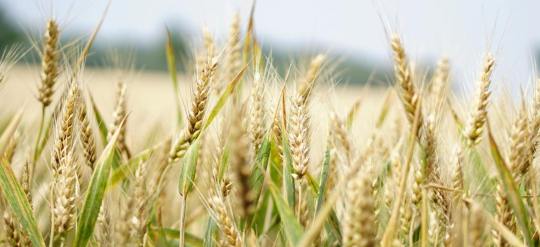
[ID: An image of yellow grain stocks, soon to be harvested. The several stocks reach towards a blurred open sky, focusing the camera on he grains themselves. The leaves of the grains are green and the cereals are exposed].
PAGANISM AND WITCHCRAFT ARE MOVEMENTS WITHIN A SELF-DESTRUCTIVE CAPITALIST SOCIETY. As the world becomes more aware of the importance of sustainability, so does the duty of humanity to uphold the idea of the steward, stemming from various indigenous worldviews, in the modern era. I make this small introduction as a viticulturist working towards organic and environmentally friendly grape production. I also do work on a food farm, as a second job—a regenerative farm, so I suppose that is my qualifications. Sustainable—or rather regenerative agriculture—grows in recognition. And as paganism and witchcraft continue to blossom, learning and supporting sustainability is naturally a path for us to take. I will say that this is influenced by I living in the USA, however, there are thousands of groups across the world for sustainable agriculture, of which tend to be easy to research.
So let us unite in caring for the world together, and here is an introduction to supporting sustainable/regenerative agriculture.
A QUICK BRIEF ON SUSTAINABLE AGRICULTURE
Sustainable agriculture, in truth, is a movement to practise agriculture as it has been done for thousands of years—this time, with more innovation from science and microbiology especially. The legal definition in the USA of sustainable agriculture is:
The term ”sustainable agriculture” (U.S. Code Title 7, Section 3103) means an integrated system of plant and animal production practices having a site-specific application that will over the long-term:
A more common man’s definition would be farming in a way that provides society’s food and textile needs without overuse of natural resources, artificial supplements and pest controls, without compromising the future generation’s needs and ability to produce resources. The agriculture industry has one of the largest and most detrimental impacts on the environment, and sustainable agriculture is the alternative movement to it.
Sustainable agriculture also has the perk of being physically better for you—the nutrient quality of crops in the USA has dropped by 47%, and the majority of our food goes to waste. Imagine if it was composted and reused? Or even better—we buy only what we need. We as pagans and witches can help change this.
BUYING ORGANIC (IT REALLY WORKS)
The first step is buying organic. While cliche, it does work: organic operations have certain rules to abide by, which excludes environmentally dangerous chemicals—many of which, such as DDT, which causes ecological genocide and death to people. Organic operations have to use natural ways of fertilising, such as compost, which to many of us—such as myself—revere the cycle of life, rot, and death. Organic standards do vary depending on the country, but the key idea is farming without artificial fertilisers, using organic seeds, supplementing with animal manure, fertility managed through management practices, etc.
However, organic does have its flaws. Certified organic costs many, of which many small farmers cannot afford. The nutrient quality of organic food, while tending to be better, is still poor compared to regeneratively grown crops. Furthermore, the process to become certified organic is often gruelling—you can practise completely organically, but if you are not certified, it is not organic. Which, while a quality control insurance, is both a bonus and a hurdle.
JOINING A CSA
Moving from organic is joining a CSA (“Community supported agriculture”). The USDA defines far better than I could:
Community Supported Agriculture (CSA), one type of direct marketing, consists of a community of individuals who pledge support to a farm operation so that the farmland becomes, either legally or spiritually, the community’s farm, with the growers and consumers providing mutual support and sharing the risks and benefits of food production.
By purchasing a farm share, you receive food from the farm for the agreed upon production year. I personally enjoy CSAs for the relational aspect—choosing a CSA is about having a relationship, not only with the farmer(s), but also the land you receive food from. I volunteer for my CSA and sometimes I get extra cash from it—partaking in the act of caring for the land. Joining a CSA also means taking your precious capital away from the larger food industry and directly supporting growers—and CSAs typically practise sustainable and/or regenerative agriculture.
CSAs are also found all over the world and many can deliver their products to food deserts and other areas with limited agricultural access. I volunteer from time to time for a food bank that does exactly that with the produce I helped grow on the vegetable farm I work for.
FARM MARKETS AND STALLS
Another way of personally connecting to sustainable agriculture is entering the realm of the farm stall. The farmer’s market is one of my personal favourite experiences—people buzzing about searching for ingredients, smiles as farmers sell crops and products such as honey or baked goods, etc. The personal connection stretches into the earth, and into the past it buries—as I purchase my apples from the stall, I cannot help but see a thousand lives unfold. People have been doing this for thousands of years and here I stand, doing it all over again.
Advertisement
Farmers’ markets are dependent on your local area, yet in most you can still develop personal community connections. Paganism often stresses community as an ideal and a state of life. And witchcraft often stresses a connection to the soil. What better place, then, is purchasing the products from the locals who commune with the land?
VOLUNTEERING
If you are able to, I absolutely recommend volunteering. I have worked with aquaponic systems, food banks, farms, cider-making companies, soil conservation groups, etc. There is so much opportunity—and perhaps employment—in these fields. The knowledge I have gained has been wonderful. As one example, I learned that fertilisers reduce carbon sequestration as plants absorb carbon to help with nutrient intake. If they have all their nutrients ready, they do not need to work to obtain carbon to help absorb it. This does not even get into the symbiotic relationship fungi have with roots, or the world of hyphae. Volunteering provides community and connection. Actions and words change the world, and the world grows ever better with help—including how much or how little you may provide. It also makes a wonderful devotional activity.
RESOURCING FOOD AND COOKING
Buying from farmers is not always easy, however. Produce often has to be processed, requiring labour and work with some crops such as carrots. Other times, it is a hard effort to cook and many of us—such as myself—often have very limited energy. There are solutions to this, thankfully:
Many farmers can and will process foods. Some even do canning, which can be good to stock up on food and lessen the energy inputs.
Value-added products: farms also try to avoid waste, and these products often become dried snacks if fruit, frozen, etc.
Asking farmers if they would be open to accommodating this. Chances are, they would! The farmer I purchase my CSA share from certainly does.
Going to farmers markets instead of buying a CSA, aligning with your energy levels.
And if any of your purchased goods are going unused, you can always freeze them.
DEMETER, CERES, VEIA, ETC: THE FORGOTTEN AGRICULTURE GODS
Agricultural gods are often neglected. Even gods presiding over agriculture often do not have those aspects venerated—Dionysos is a god of viticulture and Apollon a god of cattle. While I myself love Dionysos as a party and wine god, the core of him remains firmly in the vineyards and fields, branching into the expanses of the wild. I find him far more in the curling vines as I prune them than in the simple delights of the wine I ferment. Even more obscure gods, such as Veia, the Etruscan goddess of agriculture, are seldom known.
Persephone receives the worst of this: I enjoy her too as a dread queen, and people do acknowledge her as Kore, but she is far more popular as the queen of the underworld instead of the dear daughter of Demeter. I do understand this, though—I did not feel the might of Demeter and Persephone until I began to move soil with my own hands. A complete difference to the ancient world, where the Eleusinian mysteries appealed to thousands. Times change, and while some things should be left to the past, our link to these gods have been severed. After all, how many of us reading know where our food comes from? I did not until I began to purchase from the land I grew to know personally. The grocery store has become a land of tearing us from the land, instead of the food hub it should be.
Yet, while paganism forgets agriculture gods, they have not forgotten us. The new world of farming is more conductive and welcoming than ever. I find that while older, bigoted people exist, the majority of new farmers tend to be LGBT+. My own boss is trans and aro, and I myself am transgender and gay. The other young farmers I know are some flavour of LGBT+, or mixed/poc. There’s a growing movement for Black farmers, elaborated in a lovely text called We Are Each Other’s Harvest.
Indigenous farming is also growing and I absolutely recommend buying from indigenous farmers. At this point, I consider Demeter to be a patron of LGBT+ people in this regard—she gives an escape to farmers such as myself. Bigotry is far from my mind under her tender care, as divine Helios shines above and Okeanos’ daughters bring fresh water to the crops. Paganism is also more commonly accepted—I find that farmers find out that I am pagan and tell me to do rituals for their crops instead of reacting poorly. Or they’re pagan themselves; a farmer I know turned out to be Wiccan and uses the wheel of the year to keep track of production.
Incorporating these divinities—or concepts surrounding them—into our crafts and altars is the spiritual step towards better agriculture. Holy Demeter continues to guide me, even before I knew it.
WANT CHANGE? DO IT YOURSELF!
If you want change in the world, you have to act. And if you wish for better agriculture, there is always the chance to do it yourself. Sustainable agriculture is often far more accessible than people think: like witchcraft and divination, it is a practice. Homesteading is often appealing to many of us, including myself, and there are plenty of resources to begin. There are even grants to help one improve their home to be more sustainable, i.e. solar panels. Gardening is another, smaller option. Many of us find that plants we grow and nourish are far more potentant in craft, and more receptive to magical workings.
Caring for plants is fundamental to our natures and there are a thousand ways to delve into it. I personally have joined conservation groups, my local soil conservation group, work with the NRCs in the USA, and more. The path to fully reconnecting to nature and agriculture is personal—united in a common cause to fight for this beautiful world. To immerse yourself in sustainable agriculture, I honestly recommend researching and finding your own path. Mine lies in soil and rot, grapevines and fruit trees. Others do vegetables and cereal grains, or perhaps join unions and legislators. Everyone has a share in the beauty of life, our lives stemming from the land’s gentle sprouts.
Questions and or help may be given through my ask box on tumblr—if there is a way I can help, let me know. My knowledge is invaluable I believe, as I continue to learn and grow in the grey-clothed arms of Demeter, Dionysos, and Kore.
FURTHER READING:
Baszile, N. (2021). We are each other’s harvest. HarperCollins.
Hatley, J. (2016). Robin Wall Kimmerer. Braiding Sweetgrass: Indigenous wisdom, scientific knowledge and the teachings of plants. Environmental Philosophy, 13(1), 143–145. https://doi.org/10.5840/envirophil201613137
Regenerative Agriculture 101. (2021, November 29). https://www.nrdc.org/stories/regenerative-agriculture-101#what-is
And in truth, far more than I could count.
References
Community Supported Agriculture | National Agricultural Library. (n.d.). https://www.nal.usda.gov/farms-and-agricultural-production-systems/community-supported-agriculture
Navazio, J. (2012). The Organic seed Grower: A Farmer’s Guide to Vegetable Seed Production. Chelsea Green Publishing.
Plaster, E. (2008). Soil Science and Management. Cengage Learning.
Sheaffer, C. C., & Moncada, K. M. (2012). Introduction to agronomy: food, crops, and environment. Cengage Learning.
Sheldrake, M. (2020). Entangled life: How Fungi Make Our Worlds, Change Our Minds & Shape Our Futures. Random House.
Sustainable Agriculture | National Agricultural Library. (n.d.). https://www.nal.usda.gov/farms-and-agricultural-production-systems/sustainable-agriculture
#dragonis.txt#witchcraft#paganism#hellenic polytheism#witchblr#pagan#helpol#hellenic pagan#hellenic worship#hellenic paganism#hellenic polytheist#demeter deity#demeter worship#persephone deity#kore deity#raspol#etrupol#etruscan polytheist#etruscan polytheism#rasenna polytheism#rasenna polytheist#rasenna paganism
303 notes
·
View notes
Text
seunghan thoughts because I miss him
so we've all seen that video where they were playing the huge jenga
and when it fell he reached to kind of break its fall so that it wouldn't hurt shotaro
so I'm imagining that like
it's really common that he gets hurt a bit in the process of helping others and then brushes it off
imagine he comes home after filming that episode, maybe he's staying at your place for the night, and u see a small bruise, scratch or cut on his hand and ask about it
and he's probably just like "oh it's nothing the jenga tower fell and I got hurt a bit"
btw if you've ever had even the normal sized tumbling tower fall on your hand that shit HURTS ok the amount of times I've gotten bruises and cuts from them *shivers*
point is he tends to put other people before him
he's definitely the type of person to start picking up the larger pieces of a broken glass while waiting for someone to get a broom, just so no one else gets hurt
even if he gets hurt in the process
:(((((((((((((
imagine his s/o, you, then taking care of him cus he always does it for others
side note I just KNOW he loves hand kisses
but he wants to take care of you :(
it's just a big adorable wholesome mess with both of you babying each other
he's also SO attentive
he'd definitely keep small things about you in mind
like maybe you mentioned a snack you liked growing up and this man goes out of his way to find it and mass purchase it (like an Asian dad)
or you mentioned a book that seemed interesting when u visited a bookshop while out with your friends
Trust he's bought every book in that series for you the next day
maybe u said u ran out of catfood
when he comes over the next day, he's got a bag of the catfood
and it's tye one you use cus he checked
10000% has a period tracker for you on his phone
stocks up on snacks, pads and heating pads a week beforehand in case it shows up early
definitely the type of person who doesn't want you to consume too many painkillers because of the side effects but he won't stop you when you need them
he definitely try to look for natural pain killer recipes (as someone with horrible cramps, boiling black seed in water and drinking the water while it's warm is a VERY effective pain killer)
he strikes me as the type to pay attention to what you don't like doing and tackles those things before you
like maybe you hate doing the dishes and so when sees dirty dishes he gets to cleaning them before you can even think about it so that you wont have to
he definitely listens to you rant about your favorite book or show
even if he hasnt watched or read it
he will always listen and he loves it
he'll listen to your theories about what will happen next
and listen to you rant about how the second lead shouldve been end game
he also knows all of the tea
like omg your friend's ex is texting her again
is it pineapple or orange?
its GRAPE?!?! no way
i could honestly go on about this for hours but i'll stop here for now
#i miss him sm#seunghan come back#seunghan#seunghan fluff#seunghan imagines#seunghan x reader#riize#riize x reader#riize fluff#nini's thoughts ॢ₎
103 notes
·
View notes
Text
Rook Info Compilation part 6: Rook and Leona (pt2)
After getting information from Ruggie, Rook goes to Leona himself to confirm what he has learned, exposing Ruggie as his informant.



When Ruggie asks how it is that Leona is able to deal with Rook all the time, Rook explains, “He is a classmate and friend, as well as a rival who puts my skills to the test. At least, he is for now.”



(Rook goes to Ruggie looking for Leona and to Leona looking for Ruggie, and both tell him that they aren’t with the other twenty-four seven.)
Rook’s name for Ruggie, Monsieur Dent-de-lion, comes from when he saw Ruggie gathering dandelions from around the school to eat.
(It is a pun, meaning both dandelion in French and, literally, "tooth-of-the-lion.")
Ruggie and Rook also overlap during Glorious Masquerade, where Rook asks Ruggie to show him his technique for crushing grape seeds with his molars, saying, “I am most intrigued.” Ruggie responds, “I’m gonna say no. It’s nothing special, so you can just not look at me.”



Rook gifts Leona with a portrait he painted of Leona for his birthday.
Leona says that it’s pretty decent, but he is creeped out by the thought of how much Rook must have been watching him to have been able to make it.
Leona is Rook’s interviewer for his third birthday vignette and tries to rush through the interview, but Rook insists on drawing out their conversation and encourages Leona to ask him for more details about his best subject.
Leona acquiesces as it is Rook’s birthday. Rook makes a comment about noticing that Leona’s hair grows at a rate of 3cm per month and Leona tells him to stop watching him.


In a vignette we learn that Rook spent an entire day teaching Epel, Grim and the prefect how to craft a potion, that they then spill on accident when they leave the lab and run bodily into Leona.
Leona is not sympathetic to their plight. When Epel mentions Rook’s involvement Leona seems unconvinced that Rook could have been any help but Epel explains, “Rook happens to be a potionology expert.”
Realizing that his involvement will be revealed when Epel and Grim explain to Rook what happened to their potion, Leona decides to remake their potion, saying, “The last thing I want is to get dragged into something involving Rook.”
Epel doesn’t seem to have much faith in Leona’s potion-making abilities when compared to Rook’s, saying that “Rook said there is no absolute, surefire recipe for this potion! He said you have to start by eyeballing it as you mix it, then keep adjusting it through trial and error until you get it just right,” but Leona completes it within a few minutes, explaining that all he cares about is not getting on Rook’s bad side.


87 notes
·
View notes
Text








SMASH THE MUSEUM, I NEED OXYGEN
Elisa Chavez
exhibit 1.
My dad texts:
IS CRIME REALLY UP IN SEATTLE?
I send him a picture of the garden
at Cal Anderson's heart. Black Lives Memorial.
NO, I say.
It felt like proof to me. Diversifying
in the face of scarcity. Transubstantiating
the earth into wafers.
exhibit 2.
The oregon grape, qʷəbqʷəbčac
(qweb-qweb-chadth),
mahonia aquifolium, is "beloved
by hummingbirds and bees."
I bring coffee to tired throats,
I bring post-it notes and pens;
call me pollinator.
Black and gold, buzzing corona.
Feathered shoulders. Busy, busy.
exhibit 3.
Commenting Seattle says, Get rid of that weed patch,
then the road mural on Pine. It's eating up the space
we need for cars. Spare me your tree museum.
Your noblesse oblige,
your death printed in triplicate.
This feels like the right time to say
that I personally don't get the Mona Lisa.
Kids' art I understand: color anarchy,
eyes wilding like coals in construction paper.
Words I understand. I always stop for messages
on telephone poles and building corners:
"Wanted: the squirrel who stole my bagel";
"when I helped build this place
a worker fell down the elevator shaft and died."
The Venus de Milo, I understand: armless, beautiful.
Found in a farmer's field, where his habits
of sowing and upturning
resurrected the goddess from the earth.
This is to say that not all beauty
will make itself obvious to you.
exhibit 4.
I watch my best friend pick blackberries
straight from the bush by I-5. She swallows,
no fear. I'm too scared to eat
without permission, but I've thought of smoke
and the tart juice ever since.
I read blackberries grow especially well
on the sites of old house fires.
I hope if I have to, I'll do the same.
exhibit 5.
In the garden, we hors d'oeuvre
like it's a birthday party.
We sing, we town hall, we fucking juggle.
A man falls;
like bees, we shift to give him space.
Like bees, the gardeners tend.
Someone says, "I have narcan"
and they get him back to blooming.
Straggling, maybe.
Pretty, maybe not.
But alive.
exhibit 6.
Ms. Lyles, this one's for you.
For your children, who I pray will learn
the story of a city that did better.
Grief is a seed. It waits through winter,
sprouts between the ribs like sidewalk cracks
and puts reminders in your lungs.
It's okay to breathe your grief.
It's okay to speak it.
Our grief is a story committed to dirt.
We just hope something good
will grow.
Hey friends, if you're in the Seattle area, please consider lending your voice to saving the Black Lives Memorial Garden! There is so much you can do that would be helpful to preserving this vital space: filling out a community survey, donating, asking local orgs and businesses you frequent to sign the letter of support. And more, probably!
Please share this poem/post/the linked resources with Seattle buddies, and remember to support your local gardeners. Okay I luh you buh-bye!
128 notes
·
View notes
Note
Barev my friend. Forgive me for taking up space in your inbox but I had thoughts and nowhere else to put them. I’m American with armenian heritage. I’ve been trying very hard to track down information on my family and genealogy to no avail. Stories of my more recent ancestors were passed down to describe them as ashamed of their armenian heritage. This has lead me to believe that somewhere along the lines they forged documents or changed names in order to more seamlessly assimilate into white America. Small pieces of armenian culture were passed down, but not much.
I feel as though I’m a pomegranate seed cast very very far from my tree. Unable to grow, but still distinctly /from/ something. I’ll do all I can to honor the heritage that my family had stripped from them, and to support Armenians wherever they are, but it will always break my heart that I have to do this as an “outsider”
I pray that the future is filled with many Armenians and a strong, beautiful culture that they can proudly hold onto. Groves upon groves of pomegranates and apricots and grape vines. 🇦🇲
Barev 🌻 my friend,
Thank you for sharing your thoughts with me. Your words and your story moved me deeply, moved me to tears.
Even though you feel distant, your connection to your heritage and your roots is evident in your dedication and desire to honor your ancestors and support the Armenian community. Remember that identity and belonging are not solely determined by proximity or documentation but by the love and respect you hold for your culture.
As you continue your search, know that your efforts contribute to the preservation and celebration of Armenian heritage. You are not an outsider in spirit, for, it’s as clear as day that your heart beats in tune with the Armenian soul.
May we see groves of pomegranates, apricots, and grape vines flourish, may we live to see our nation and our country prosper, retrieving what’s been lost.
What I need you to know, my friend, is that your journey honors your ancestors and enriches the Armenian heritage. 🇦🇲 ❤️💙🧡
27 notes
·
View notes
Text
Dear Sephiroth: (a letter to a fictional character, because why not) #265 (part 1)
I had a beautiful solo adventure today. And I got so many awesome pictures for you in the process that I'm going to have to break it up into two parts, at least. I'll start from the beginning!
I finally got around to making another loaf of garlic bread. Of course, I already did some of the preparation for it yesterday, what with peeling the garlic and taking the butter out overnight to soften. Today, I cut off the woody ends of the garlic, and chopped them in my handy-dandy veggie chopper:


That represents two full heads of garlic. I would recommend that a person of more ordinary levels of garlic tolerance should probably only use one head of garlic at most; my taste for alliums quite possibly borders on insane, ahahaha~!
In any case, with this, I mixed together two sticks of butter, a bunch of dried herbs (basil, parsley, marjoram, oregano, and ground coriander), salt, and parmesan cheese:


From there, I sliced the bread in half, divided my butter in half, and spread each half of the butter on each half of the bread:

...I baked this in the oven at around 400 degrees F (or 204.4 degrees C) for about 15 minutes. Last time, I spread the mozzarella cheese on before putting it in the oven, and so the garlic didn't get toasty. I didn't have that problem this time:

...Roasty, crispy edges, and roasty, crispy garlic... This came out so perfectly.
From here, I decided that the thing to do was try a Korean-ish-style garlic bread again. We had this cream cheese that we don't have bagels for, and it needs to get used, so I softened it in the microwave, divided it in half, and applied it to each half of the garlic bread:

...From there, I applied a whole bag of mozzarella cheese to this, divided evenly between each half of the bread, like so:

...And then I stuck it under the broiler for a couple minutes to get it all melty!

...It turned out absolutely perfectly:

...I wish you could be here to try some of this with us. I wish so badly that you could have eaten some of this. But maybe someday, when you're safe and free from all the weird bullshit that surrounds you, you can look back on this letter and remember how to do this, so that you can have some in your own house with all the people who care about you.
In any case, since today was Monday, and since it was also rainy, I went to the orchard, confident that I'd basically be the only person there. Sephiroth... have you ever been to an orchard? They grow lots of things there. Usually in my area, they're known for apples:



...However, I was here for the grapes. Specifically, I was here for concord grapes:










...Sephiroth, have you ever had concord grapes? They're intensely sweet at first, and they have a tart finish. They have seeds, and they slip out of their skins. Because of the fact that they slip out of their skins so easily, they're actually kinda fragile; you have to be very careful about how you pick them and transport them, because they're plump, heavy, and eager to fall off the vine or slip out of their skin. Just being set down into the bag a little too roughly will do it. And then you get a little bit of grape juice everywhere...
Sephiroth. If you've not had concord grapes, you gotta try 'em. They're one of my favorite things, like ever. They rival even my love of garlic. They rival even my love of cheese. They rival even my love of sushi. And if you've been reading my letters up until this point, you'll know that that's really saying something!!
Hey, Sephiroth? If you ever find yourself in my neighborhood when these are in season, you wanna go together to grab some up? The drive there is beautiful, too; I think you'd have an amazing time. Even though I know it's impossible... I'll still ask you to please come along with me sometime.
I'm at 23 pictures already, and I still have so much more to show you. So I'm going to end this part of today's letter and begin the next one.
I love you!!! I'll write again in literally just a little bit!!!
Your friend,
Lumine
#sephiroth#ThankYouFFVIIDevs#ThankYouFF7Devs#ThankYouSephiroth#final fantasy vii#final fantasy 7#ff7#ffvii#final fantasy vii crisis core#final fantasy 7 crisis core#final fantasy crisis core#ffvii crisis core#ff7 crisis core#crisis core#ff7r#final fantasy vii remake#final fantasy 7 remake#ffvii remake#ff7 remake#final fantasy vii rebirth#final fantasy 7 rebirth#ffvii rebirth#ff7 rebirth#final fantasy 7 ever crisis#ffvii ever crisis#ff7 ever crisis#ffvii first soldier#adventure days#beautiful days#wholesome
9 notes
·
View notes
Text
My Garden Flowers Part 2
All photos mine. The narrow-leaved sundrops photo is edited for colour since the camera apparently can't reproduce that intense of a yellow. Neither can any Photopea editing, but at least it's closer. It's the bright of highlighter yellow but more golden.























In order of appearance:
031. Philadelphia fleabane (Erigeron philadelphicus) A welcome "weed" I couldn't find available at any of the native plant places in Ontario (one in Manitoba carried it but it wasn't available) but she planted herself.
032. Canadian Lettuce (Lactuca canadensis) Another welcome "weed" that sadly didn't manage to reseed, but maybe one will turn up again.
033-034. Jack-in-the-Pulpit male and female flowers (Arisaema triphyllum) The male has one leaf set while the female has two. The babies only have a leafset and no flowers for the first couple years of their lives. Then they reach sexual maturity as males, the next year they'll be female and switch back and forth until the end of their lives.
035. Early Meadow Rue (Thalictrum dioicum) Not pictured as she hasn't flowered yet. She's new. Hopefully next year.
036. Creeping Oregon Grape (Mahonia repens) First they gave me a non-native cinquefoil but thankfully rectified it by giving me two of these when I'd only ordered one. They've flowered before, but never so profusely as they both have this spring, and there are a number of berries ripening! They also made a baby from previous years, or else one of them suckered.
037. Three-Leaved Coneflower (Rudbeckia triloba) So...I planted her. She died. I swear she died, like root and all, she did not make the winter. Didn't come up in the spring. But now she is in several places! Managed to reseed herself? Perhaps. I don't recall that she flowered the year I planted her. Had dormant seeds in her pot with her? Coincidental present from squirrels? Either way, she's roughly in the spot I wanted her and is flowering well. Who cares how she got there?
038. Witherod Viburnum (Viburnum nudum cassinoides) Not pictured as she hasn't flowered yet. Hopefully next year!
039. Purple Milkweed (Asclepias purpurascens) Not pictured as she hasn't flowered yet. She's a new milkweed species for me! If she makes it through the summer and then the winter I should have more flowers to post in a year or two. :)
040. Rosy Pussytoes (Antennaria rosea) Not pictured as she hasn't flowered yet. Surviving, though, which is saying something because not even weeds grow there. It's a very dry spot and I've been kind of neutred from watering. But I read that she likes dry and that spot is dry. So good luck to her.
041. Prairie Alumroot (Heuchera richardsonii) Not pictured as she hasn't flowered yet. Also surviving in said very dry area.
042. Ramps (Allium tricoccum) I really hope her seeds made baby ramps! They only flower after reaching maturity at seven years, which is why it's bad when people come and uproot the lot of them. And I mean, they taste nice but not where I understand why people do that.
043. Spicebush (Lindera benzoin) My native allspice substitute! Her berries are currently developing and will be red in the fall. Still hoping to attract spicebush swallowtails one day.
044. Bigleaf Lupine (Lupinus polyphyllus) Was supposed to be sundial lupine but definitely isn't. There is disagreement between VASCAN and the USDA over whether there is a single variant of one subspecies of L. polyphyllus that's native to Ontario. This one stays in my garden until that's settled. Anyway, she's a gorgeous plant but the reason to avoid intentionally planting it in Ontario is that it easily hybridizes with sundial lupine. The hairstreak caterpillar can only eat true sundial lupine leaves. I don't know if the variant that the USDA says is native is a misidentified hybrid (bad, but also doesn't seem like it because the variant listed by the USDA is Lupinus polyphyllus ssp. polyphyllus var. polyphyllus) or just a well-behaved variant (fine, just like there's a native subspecies of Phragmites australis). But again, I'll be leaving mine in until I learn for sure, and I won't be planting sundial lupine there to avoid hybridization.
045. Sweet Joe-Pyeweed (Eupatorium purpureum) Fuzzy flowers! She can get very tall. I'm also finding out she's a slow spreader as there is an individual nearby that I didn't plant.
046. Tall Bluebells (Mertensia paniculata) She survived several years and seemed to do well, but she didn't come up this spring. I'll need to get another one and try a spot that's not quite so tough.
047. Poke Milkweed (Asclepias exaltata) Not pictured as she hasn't flowered yet. But this is her second year, so to judge by some of my other species she should do it next year!
048. Narrow-Leaved Sundrops (Oenothera fruticosa) No flowers I've seen are as intensely yellow as those in this genus, and narrow-leaved sundrops and evening primrose in particular seem to just glow.
049. Cup Plant (Silphium perfoliatum) The coolest part of this plant is in the name: the bases of her leaf stalks wrap around the flower stalk to make cups at the joints. Water settles there and birds come to drink. I haven't seen this happen yet, but I'm waiting. The flowers, however, are quite sizable, very pretty, and attract lots of bees. She gets tall like some common sunflower cultivars.
050. Canada Violet (Viola canadensis) She barely came back this year after doing well for several. I think it was just a dry winter, but the point is for them to be able to survive all seasons any year, so I'm going to try somewhere else.
051. Stinging Nettle (Urtica gracilis) I'm assuming, anyway. She planted herself in my garden at my former apartment and I potted and took her with me when I moved. She's been doing okay. And bitey. She's very bitey.
052. Zigzag Goldenrod (Solidago flexicaulis) I didn't plant that, so free native plant for me! She's also made babies.
053. Cutleaf Coneflower (Rudbeckia laciniata) Finally flowering this year!
054. Lowbush Blueberry (Vaccinium angustifolium) Not pictured as I haven't got pictures yet.
055. Highbush Blueberry (Vaccinium corymbosum) A cultivar, though I can't remember which. I try to avoid cultivars and get the wild type if I can, but it's not always possible and not all cultivars are bad.
056. Lance Selfheal (Prunella vulgaris lanceolata) Selfheal is a common garden weed but unobtrusive and makes cute purple flowers. Not to mention edible and medicinal uses! This one is the subspecies native to Ontario proper, whereas her close cousin is common up here but apparently only native to the northeastern United States bordering southern Ontario.
057. Dense Blazing Star (Liatris spicata) She's fuzzy. She's magenta purple. Bees love her. She's perfect.
058. Fairy Candle (Actaea racemosa) She's related to the baneberries and is herself poisonous but she does have some limited edible uses. And her delicate white flowerheads are lovely.
059. Star-Flowered Onion (Allium stellata) So glad I was able to get her before the place that sold her stopped shipping to my province. No one in my province carries this! But she is native, I have her, and she is an ever green plant that simply resumes growth as soon as the snow melts.
060. Wood Violet (Viola sororia) Other than V. odorata, which is invasive in North America, if you see the classic blue, purple, and white violets growing everywhere in the spring in North America it's probably this species. Yes, violets can actually be blue! Not the sky blue of forgetmenots, dayflowers, or bluebells, or the deep blue of lobelias, but blue.
#blackswallowtailbutterfly#my photos#photography#my garden#garden flowers#native plant gardening#native flowers of Carolinian Canada and USA#Erigeron philadelphicus#Lactuca canadensis#Arisaema triphyllum#Clinopodium vulgare#Mahonia repens#Rudbeckia triloba#Allium tricoccum#Lindera benzoin#Lupinus polyphyllus#Eupatorium purpureum#Mertensia paniculata#Oenothera fruticosa#Silphium perfoliatum#Viola canadensis#Urtica gracilis#Solidago flexicaulis#Rudbeckia laciniata#Vaccinium corymbosum#Prunella vulgaris lanceolata#Liatris spicata#Actaea racemosa#Allium stellata
11 notes
·
View notes
Text
Hi everyone I’m sorry I haven’t updated as much as I planned, but I thought I’d share pics of how everything’s going in my garden (6/23/24)
The tomatoes have exploded and there’s lots of flowers. I’m hoping it’s not too hot and we actually get fruit this year (last year got so hot our tomatoes didn’t even flower during the normal growing season).



Next is the corn, which are also doing really well. It’s the sweet corn variety. Funny story, I planted the corn seeds without knowing you kind of need a lot to get a good crop because it’s wind pollinated. However, we have about 10 mature stalks and I’m hoping to get at least a small harvest. A few of the stalks are taller than me (5’3”/160cm) and one of the ears growing already has silk growing out of the ear.

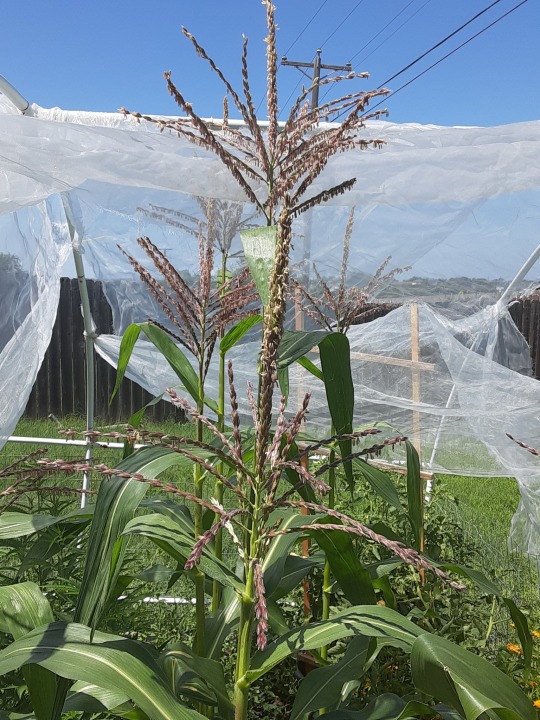

Next are the cucumbers. One of the plants has a few eggs on the bottoms of the leaves so I used some Sevin dust. I’m hesitant to use neem oil because I’ve noticed lots of ladybugs in the garden and don’t wanna kill them.




The carrots are doing well after being transplanted. Unfortunately I don’t remember when I started the seeds so I’m not sure if they should be farther along by now (I believe I planted around late April/early May—late for seeds I know but I’ve got a long growing season and few frosts).
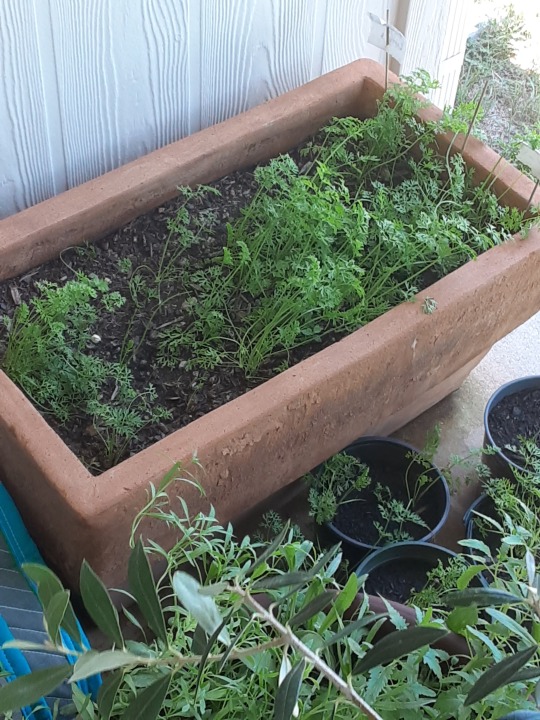
The various fruit trees/bushes/shrubs are doing well. Pictured are a thorny blackberry vine, an olive tree, a papaya tree, and a babcock peach tree. Everything is doing amazing. The blackberry is producing, the 4 peaches are growing and changing color while the olive, fig and papaya have been putting in some major growth/establishing.

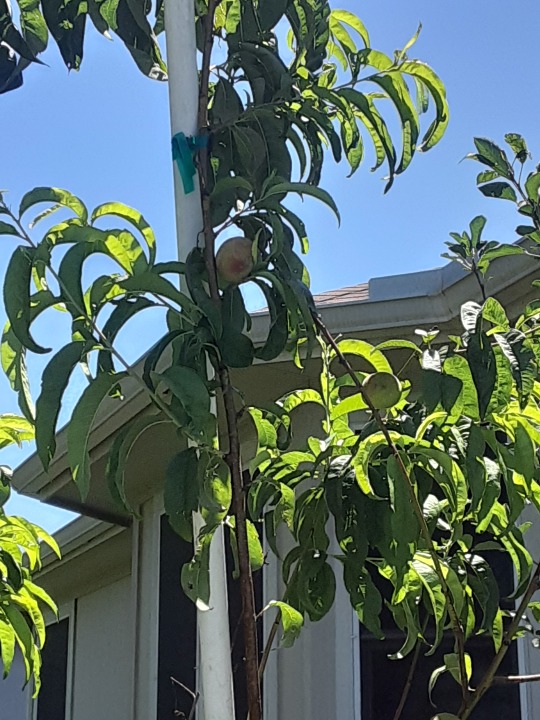



Last is the melon patch. It’s also exploded and there are so many watermelons throughout the whole patch of varying sizes from bb-sized to the one pictured with my hand. I didn’t see any cantaloupe yet, but there’s lots of flowers. I haven’t actually gone into the patch due to how crowded it is (I’m hoping if we do get some we’d be able to see them when they get big enough). I’m estimating we have between 12-15 watermelon at least so far.



However, not everything is doing so well. The rabbits have been so destructive, they killed my producing pole bean, the peppers I transplanted into the ground and most of the radishes, leaving 2 left for us (I did start new seeds though because radishes are some of the quickest vegetables you can grow from seed to harvest).

For things I didn’t cover like the grapes, blueberries, raspberries, guava trees, the apple tree, the lemon tree, various flowers, onions, potatoes, and pineapples, they are all doing good as well. I also wanna add that I did start new bush beans/pole beans as well as various kinds of peppers (jalapeños, hot salsa blend peppers, golden bell peppers) in containers to make up for the ones that got chewed. Hopefully those will make a nice fall harvest. The potatoes are almost ready to be harvested and the blueberries and raspberries have had berries ripen one at a time due to how small they are (this is the first year for berries).
As for other things I have planned, I have a few art pieces I’d like to post if that’s something y’all are interested in. I also would love to talk about my experience with gardening and mental health but any and all posts related to that will be labeled with appropriate trigger warnings.
Thanks for all the support with likes/reblogs. Feel free to come lurk, talk, vent, ask, whatever. I just wanna inspire others that think they cannot grow things that they can. If you’d like to talk I mostly would like to talk about gardening/plants/mental health and how it impacts us as humans.
Happy growing🌱🌿💙
#gardening#garden#garden update#gardencore#gardeningcore#melon patch#so proud of the watermelon#really everything because we did almost everything from seed this year#to save money and help with buying perennials like blueberries and fruit trees#instead of transplants that are like 5-10$#planting things from seed is so satisfying#like I turned a hard dry thing into a living thing that gives me food#vegetable garden#fruit garden
11 notes
·
View notes
Note
You’re a grape farmer for a winery, spending your days mostly alone and tending to the fields.
The god Dionysus takes a liking you you, such a plump figure taking such good care of one of his domains. How could he resist you? How could you resist him? The god of wine and pleasure, mesmerizing eyes and wandering hands undressing you in your fields. The smell of sticky sweet grape juice as he enters your cunt, bigger than any partner you’ve ever dared have and hitting your most sensitive areas with every thrust. Fucking you from behind, onto the ground as the heat takes over. He moans into your shoulder as he cums inside of you, you feel slightly taut from the size of his load.
Lord Dionysus is also a god of fertility after all, and as he pulls out and caresses your body you can already feel yourself changing. The seed he left inside of you fertilized and sprouting, growing rapidly in your womb.
You begin to moan again as the tendrils of a plant twist inside of you, growing longer and thicker with every moment. Not only filling the space they’ve been given, unfurling and expanding until you can see your belly growing to make room. Other tendrils- perhaps roots?- make their way down your cunt towards your entrance, getting thicker and thicker as they go.
The roots of a curling vine push out of you, and you can see past your growing stomach that they must each be a centimeter in length and only getting bigger, beginning to stretch your hole as they reach for soil.
Your lord has been stroking your body this whole while, watching the effect of his seed on such a faithful follower. He picks up your swelling body effortlessly, and you moan as all of the plant life inside you shifts with gravity. The roots dangle out of you, stretching your entrance to the size of a fist… but now displaced from the soil they were seeking. They hang heavy from you as your Lord walks off with you, the two of you disappearing to *his* garden for your vines to grow and root you into the soil. And so, of course, he can enjoy what his new pet grape boy will produce for him….
(No harm done, but not a fan of something aimed at me including references to a womb! Nowadays that language is a bit uncomfy for me and prefer just a vague kind of 'inside you' type thing)
Ooooo, turning into Dionysus' personal grape boy sounds wonderful~ Especially the idea of being rooted down through my cunt like damn... the stretch and writhing of those roots would feel amazing i bet, and I can only imagine what would happen to my body once I have been properly rooted
Would I swell overall huge and juicy like a perfectly flavorful grape? Or would I just become pleasantly swollen with big tits that leak wine and my belly still pushed out from all the vines inside me? Either way, what a blissful existence tended to under Dionysus' care
53 notes
·
View notes
Text
On The Blessedness Of The Fruits Of Summer
A homily for Lammas, 2024.

Dearly beloved,
A very blessed Lammas/Lughnasadh to all of those in the northern Hemisphere and a very blessed Imbolc to our siblings in the Southern Hemisphere! May all of your hopes and dreams grow into fruition over the coming year!
For us in the Northern Hemisphere, this holy day is about the ripening of the first fruits of the year. Here in my home in Northern California, we are welcoming in apples, grapes, melons, berries, and citrus of all kinds, as well as artichokes, avocados, and summer squash, and I can tell you, I am reveling in all of these wonderful foods. As such, I am moved to speak this Lammas on the blessedness of the fruits of Summer.
The fruits of Summer are special. The first fruits of the year’s harvest have ripened and our tables and homes welcome them. Our plates abound with fresh bread, fresh fruit, and fresh vegetables, and we walk happily in the warm days and cool evenings as the days start shortening in earnest. And all of this was due to our hard work (if we are lucky enough to be able to grow our own food) and the hard work of farmers, pickers, washers, distributors, and other diligent workers over the course of the Spring and early Summer. While some of us might be lucky enough to live where the fruit and grain grows wildly and freely for all to take as they need, most likely the food on our tables on any given day came from the hard work of many people.
In the same way, in our spiritual lives, this time of year tends to occasion moments of fruition. As pagans, we believe in a naturalized theology, and accordingly we tend to see moments of spiritual realization coming to fruition as the natural world moves towards its own moments of fruition. This is a time where the seeds of the new selves we planted in Spring and the hard work we have done since then are bearing their first fruits, and thus it is a moment of initiation. Lammas is a feast, a celebration of the fruits of Summer, yes…but for those of us who live the spiritual life, it is also a moment where we begin to enjoy the first rewards of our spiritual work—the Great Work—that we have been doing over the course of Spring and Summer.
So celebrate yourself as you celebrate these first fruits of Summer. You have cultivated yourself and been cultivated by the Divine, and now you can enjoy some of the rewards of that cultivation. Celebrate the fruits and grains of Summer, yes, but also celebrate the person you are becoming as the Wheel Of The Year turns.
I also want to honor the blessed god Dionysos in this moment. Grapes are one of those fruits of Summer, and the Olympic performance has brought our beloved Dionysos to the fore of minds of the general public for the first time in centuries, perhaps millennia. More people are speaking the name of this great deity, who, in the Orphic tradition, is the inheritor of Olympus and the Heavens as Zagreus, than perhaps ever before in history. So in this moment let us honor great Dionysos and remember His gifts! Ιο, ιο Διόνυσος! Blessings and worship unto Thee, Great God!
And blessings to you, dear reader, and bright blessings upon your Great Work. Blessed Imbolc! And hail Dionysos!
In love,
Soror Alice
Art: Giuseppe Arcimboldo, “Summer”, (1563)
#spiritual#spirituality#mystical#mysticism#religion#pagan#paganism#magick#witch#witchcraft#magic#ceremonial magic#ceremonial magick#lammas#Lammas 2024#sabbat#homily#Summer#dionysus
9 notes
·
View notes
Text
Caelwynn's Mod List for Stardew 1.6 - Gameplay/Quality of Life (pg 2)
Page 1. Page 2. Page 3.
No Fence Decay Redux — never worry about needing to fix fences ever again.
NPC Map Locations — another must-have mod. Shows you the locations of NPC in real time on your map.
Part of the Community — gives small friendship bonuses based on your relationships with NPCs' friends/families, times they've witnessed you talking to/giving gifts to others, and whether you're buying at their shops.
Platonic Partners and Friendships — for if you wish you could have an NPC room with you without the all that icky marriage stuff
Polyamory Sweet — for if you wish to keep a harem and/or have a roommate in addition to your spouse and/or have a commune of nothing but friends.
Quest Time Limits - Continued — a configurable mod that allows you to extend the amount of time that quests last for.
UI Info Suite 2 — overhauls the game's user interface.
Wear More Rings — lets you wear more than two rings. I'm greedy.
Little Red School House — adds a quest line to restore a school house so that Penny no longer teaches in the library.
Yet Another (Balanced) Quality Goods Mod — adjusts the quality of artisan goods based on the quality of ingredients as well as adjusting the profit accordingly.
Blue Eggs and Golden Mayo — allows you to make blue eggs/blue mayo from blue chickens, and golden mayo and ostrich mayo.
Ferngill Fashion Festival for 1.6 — adds in a series of heart events for Emily and a new festival.
Farmhouse Visits — allows you to set a configurable chance for NPCs to decide to visit your farmer.
Nondestructive NPCS (Unofficial update) — prevents NPCs from destroying your decor/items if they're blocking the NPC's path.
Brown Cows Give Chocolate Milk — Exactly what it says. Also allows you to make chocolate bars from chocolate milk.
Mako's Spam Mail — adds in a plethora of spam mail/advertisements/chain mail that you can receive each day. It makes me cackle at least once each play sessions.
Better Junimos — allows Junimos to automatically plant crops, fertilize, water plants, harvest forage, clear dead crops, and NOT harvest your flowers.
Starfruits Will Regrow — turns starfruits into a plant that produces throughout the season ala tomatoes or grapes.
No Soil Decay — prevents tilled soil from reverting if it doesn't have a plant in it overnight.
Self Serve for 1.6 — allows you to buy from shops even when their owner is away at aerobics or otherwise unavailable.
Waterproof Items — items that fall from trees float in the water instead of sinking, allowing you to collect them.
Lovely Digspot — changes the appearance of digspots to make them easier to see. I'm blind as a bat and this is INCREDIBLY helpful.
Greenhouse Sprinklers — allows you to eventually purchase overhead sprinklers from Robin so that you can maximize your growing space.
Better Crafting — an extensive overhaul of the crafting system. I mostly use it for the ability to bulk craft.
Magic Workbench — gives your workbench a much farther reach with regards to your chests.
Better Chests — allows for better organization and search/filtering capabilities for your chests.
Bigger Backpack — allows you to purchase an additional row of storage space in your backpack.
Event Limiter — limits the number of events you can see in a day, plus how many you can see back-to-back. Configurable.
Relocate Farm Animals — allows you to easily reassign what barn/coop/hutch animals are in.
Colored Seeds for 1.6 — changes the color of seed packets to reflect what season(s) they grow in.
Social Page Order Redux — gives a filter function to the social page so you can see them divided out in different ways.
Schedule Viewer — pulls from game files to show you where NPCs are going throughout the day and at what time.
It's Still You — the mirror in the bathhouse quotes an iconic line from Undertale.
What Do You Want — provides in-game lists of requirements to complete different parts of the game, excluding what you've already completed. Lists include the community center, Grandpa's evaluation, golden walnuts, and various achievements.
Mail Services Mod — gives you the capability to mail gifts to NPCs, as well as mail off your tools for upgrade and receive them from Clint once they're done.
The Masterpost for all of the mods is located here.
#caelwynn's mod list#stardew valley#sdv#stardew valley mods#stardew mods#sdv mods#modded stardew valley#stardew 1.6#stardew QoL mods
11 notes
·
View notes
Text
10 October 2023 - Friday Field Notes

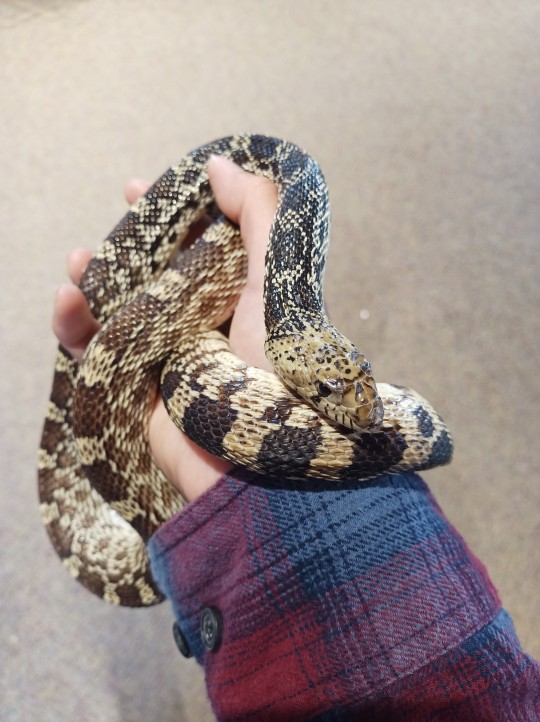
Fall is here. The days are getting shorter and the nights are getting colder. Got to spend some time at one of the other offices this week. All the leaves are starting to change and I haven't seen this little lady in a while.
This bullsnake is an education animal, not a pet. I know they're cute, but wildlife needs to stay wild and should not be kept as pets.
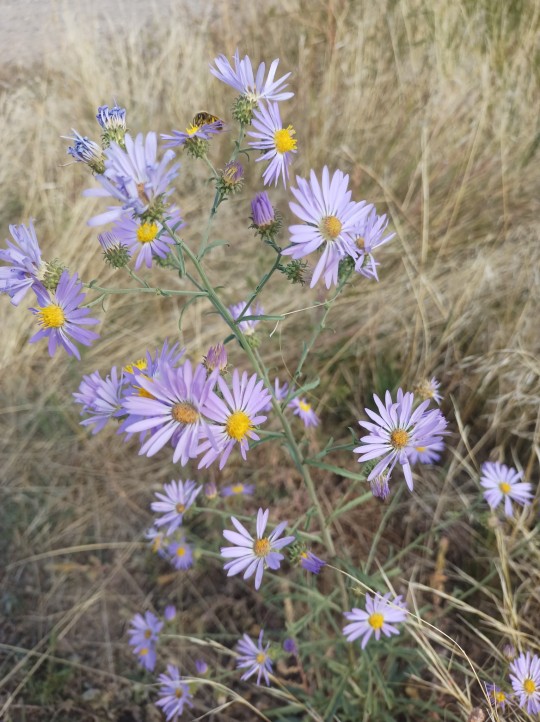
These tansy asters are some of the late blooms you'll find on the prairie. Many native flowering plants have staggered bloom cycles, some flowering plants bloom as early as Apri, if conditions are favorable, while others species bloom as late as October or November. In biodiverse rich ecosystems, you should be able to see flowers throughout the season at different times. They take turns sharing the stage. This not only reduces competition between plant species, but also allows wildlife species to utilize resources throughout the growing season. Healthy ecosystems are good at supporting all the things in it. Can you spot the bee?

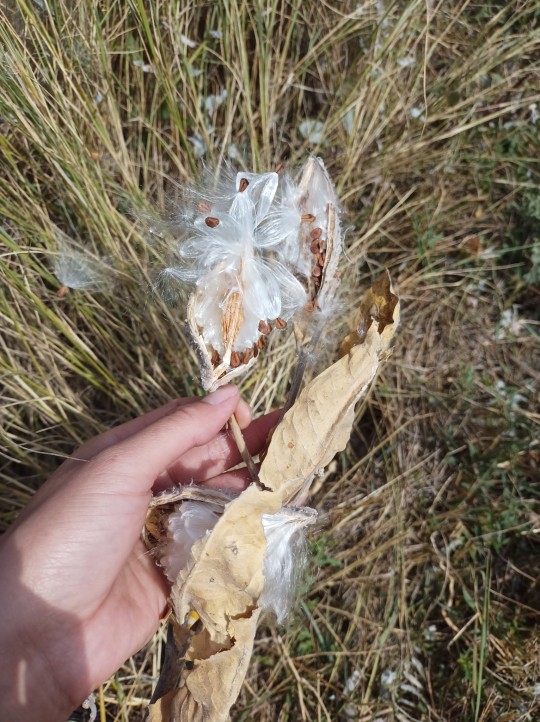

Most plants out here have gone to seed though, like the sunflowers, showy milkweed, and the false boneset.
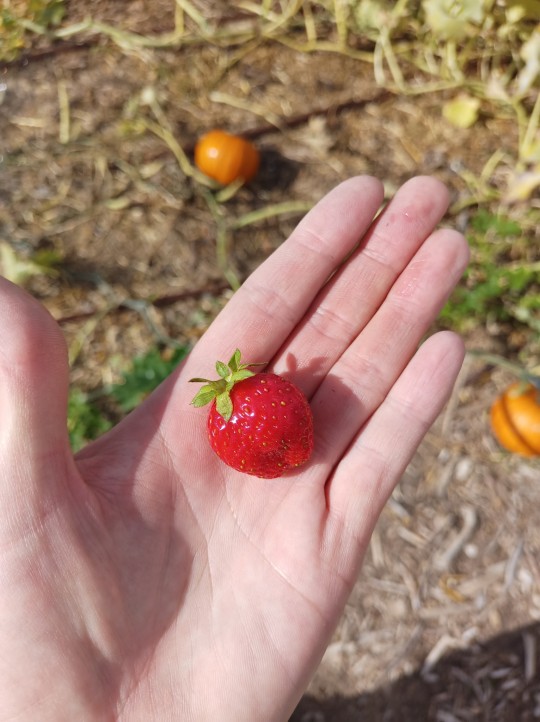
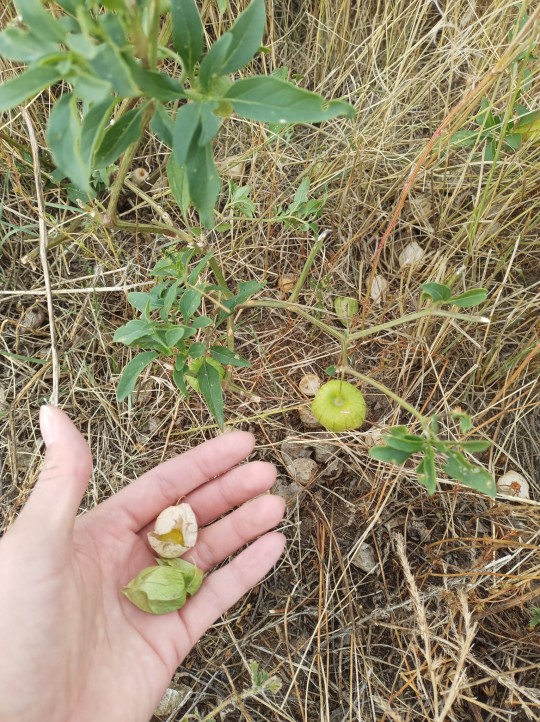
And it also means time to harvest and eat stuff. Strawbaby from the garden, a cultivated plant, and common ground cherry, found growing out on the prairie.
(@irrigone finally found some ground cherries that were ripe enough to eat! They have the consistency of a tiny grape and they kinda taste like sweet tarts candy. Not bad. Ate a couple and didn't die 👍 Would recommend as a light snack.)


Exoskeleton of a plains lubber and some fringe sage. One of my fav plants out here, smells delightful.

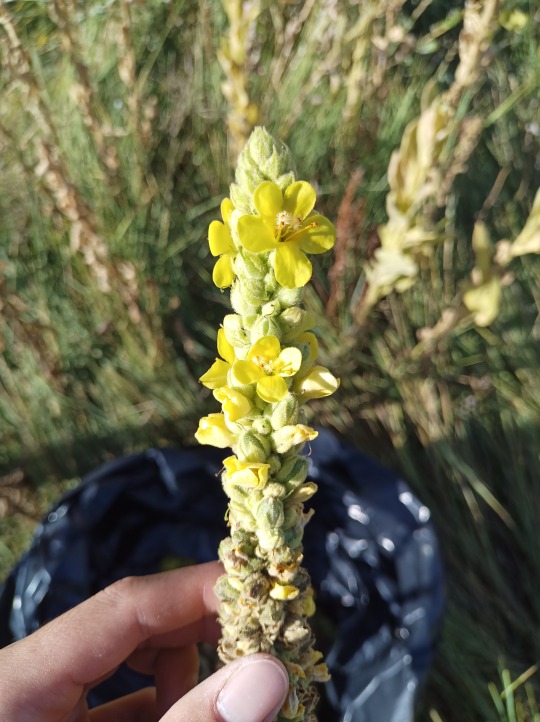


And one of my not so favorite plants (at least out here, totally cool if found in its native home range) Mullein is a biennial plant, meaning it has a two year life cycle, and it's an invasive weed in my neck of the prairie, and arguably, the rest of the Great Plains and grassland habitats in N. America.
The first year it grows as a basal rosette, close to the ground. Basal plants grow from the root base as opposed to forming new tissue towards the top. Most grasses grow this way too, which is why you can mow it without killing the whole plant. Same thing with mullein. In order to make sure the plant does grow back during manual removal you have to pull up the tap root as well.
The second year they'll flower, and produce these massive flower stalks that produce hundreds of seeds. And they're all tiny. Some stalks can get up to 3-4 feet tall and produce thousands of seeds that stay viable in the ground for years. It's no wonder they get everywhere and are so hard to manage.
Invasive species can take over ecosystems if left unchecked and reduce the biodiversity and overall health of native habitats.
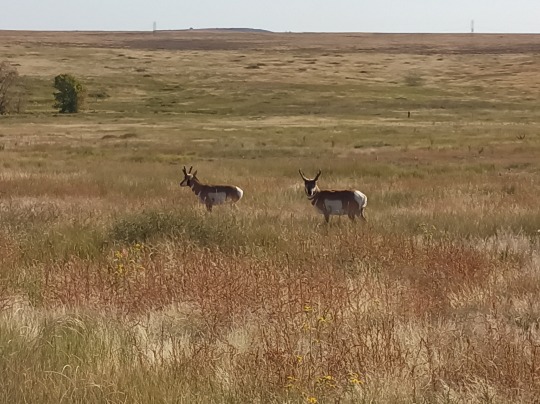
Weed management strategies and good land stewardship practices help support wildlife. Like these pronghorn. Wildlife will stick around in habitat if they can get the resources they need to survive and thrive.
Pronghorn, often referred to as antelope, are actually more related to giraffes than antelope. They're also the second fastest land animal in the world and can reach sustained running speeds of 55mph. They prefer wide open grassland habitat.
Fall is rutting season, so all the boys have been extra feisty lately and chasing everyone around. Been getting a lot more stare downs from them lately.
#friday field notes#nature#biology#ecology#nature conservation#little ghost on the prairie#lot of shots of my hands this week#me picking strange things off the ground#eating strange things off the ground#forgot to post this yesterday lol#shortgrass prairie#prairie#grasslands#pronghorn#plants#bullsnake
28 notes
·
View notes
Text
Little flame: Daddy Diluc x toddler daughter reader x uncle Kaeya



Age:4 reader Chan is Diluc's toddler. She is an adventurous ball of energy that Diluc and Uncle Kaeya love to death until she got her vision. Outfit above is what your wearing.
You are in the grape vine field chasing the Anemo crystalflies. Your father is in the manor doing paperwork in his study while the maids are watching over you and hanging up laundry "Don't run of to far young Miss." Adelinde said "Ok Addy." You said continuing to chase the sky blue creatures "Hillie! Moco! I have to make lunch, can one of you watch the young Miss?" She asked "I'll do it." Moco volunteered "Ok! Moco is in charge of Y/N and Hillie just continue hanging up the laundry." Adelinde said walking into the manor to get started on making lunch.
After Hillie finished hanging up the last of the laundry she and Moco decided to gossip about what was in the basement of the manor unaware of you running farther from the manor grounds and towards a hilichurl camp with four Abyss mages doing a ritual (It would be awesome to have Electro mages in Mondstadt and Liyue.)
As you chased the crystalfly you saw that it got tired and disappeared into the air "Bye Bye crystawfwy." You said until you heard loud growling and saw the four mages appear in front of you. Getting scared you tried running but a Mitachurl grabbed you by the collar of your trench coat Adelinde made for you on your birthday "DADA! UNCWE KAE!" You screamed at the top of your longs but you knew nobody heard you when one of the mages floated over to you "She's one of them." It said in disgust conjuring a spell with its staff while doing the dance. You got scared and whimpered but a warm but comforting feeling came "Don't be frightened little one." A caring voice said to you as you felt a fire around you.
Soon all the enemies are dead and turning into purple smoke. You looked around and saw a vision on your hip just like your fathers "Brother I see her." You heard your uncle say seeing your scarlet hair as he and your father ran up to you "Y/N you can't be running off like that." Diluc said scooping you up into his arms "Sowwy Dada." You said melting his heart "It's alright little flame, you can't help your curiosity." He said hugging you closely "Looks like someone earned her vision today." Your uncle said pointing at the scarlet vision on your hip "Good job little flame and at four years old." Diluc sad hugging you closer until a dandelion seed flew past your nose making you sneeze causing a catalyst to appear "Looks like we have another mage in Mondstadt." Kaeya said patting your head "Just what we need! Another Klee." Diluc said as he and Kaeya make haste for the manor. Bye the time they got to the Manor they saw Adelinde Scolding Hillie and Moco who are both on they're knees while apologizing with bumps growing on their foreheads "I gave you one thing to do Moco! One thing." She said with flames in her eyes making her look scary even your father was scared "Let's just go to the good hunter." Diluc said grabbing Kaeya's arm "STICKY HONEY WOAST." You said excitedly making your father and uncle chuckle "Alright little flame." Diluc said adjusting you in his arms as you laid your head on his shoulder.
#genshin impact#dad Diluc#uncle kaeya#platonic#toddler reader#baby reader#child reader#female reader#cute#teyvat#mondstadt
115 notes
·
View notes
Text
How To Dilute Essential Oils
Be ready for a long one. Essential oils can be tricky. And they are something you don't want to be using undiluted for the hell of it or because an article you read claims it's more potent if you, ya know, put it directly on (yikes, don't fall for that!). I got certified in aromatherapy five(ish) years ago for the hell of it & to help my business for in-person clientele. While I don't use it as much as I used to, I did learn all the proper dilution techniques that I thought I would share here!
Before I dive into this breakdown, know that it is in your best interest to dilute any essential oil. While lavender doesn't cause a reaction out of most people, it is still in a highly concentrated form. There are many oils, such as cinnamon, that you should never put on your skin without diluting first, as it will cause irritation. It falls into a category of "hot oils" which means that you will feel a tingle or burning sensation, depending on your skin type. Tea tree and lavender are the only two you can use undiluted (and if you have sensitive skin, you may still want to dilute to be on the safe side) - for anything else, you should be grabbing your carrier oil.
Do not replace the carrier oil with water. You remember that you learned somewhere growing up that water and oil do not mix? Yep, same rule applies. They will separate and the oil will still go directly into your skin.
That being said, carrier oils that have nourishing properties for the skin tend to be best. Jojoba, coconut, almond, hell even olive oil all work. The essential oil sticks with the fats in the carrier oil and will slowly absorb into your skin (via the fat in your skin). All of this prevents skin irritation. You can buy these in bulk for a discounted price if you find yourself using essential oils on a regular basis to save on money.
Carrier Oil Breakdown
• Jojoba - usually a favorite of many people that use essential oils in their skincare products. Odorless, non-greasy, a little waxy.
• Coconut - light, doesn't go rancid or leave residue, good for every skin type! You can also use it in a wide range of product types.
• Grape seed - mostly odorless. Best for delicate skin (sensitive skin, for the elderly, etc.)
• Olive oil - heavy & can be greasy, so buy the light stuff. Has strong odor. High in vitamins and minerals, very good for your hair and skin! Be aware though that it will leave some residue until fully soaked in & can clog pores. Personally, I use this a lot for my anointing oils or salves.
• Almond - slightly oily. Best for dry or irritated skin. Beauty & health recipes.
So, some quick pointers.
• Firstly, best way to remember it is it is 1 drop of essential oil per 1 tsp of carrier oil.
• 1% is recommended for children, the elderly, and immunocompromised. 2% dilution for a healthy adult. 3% for short term, small areas (if you're washing it off right away or sometimes in the situations of pain relief).
• Make sure you are diluting if using for hair care.
• Make sure you are diluting if adding into the bath. Remember, oil separates from water. Put the diluted mix in.
• Also, if you're trying to mix essential oils, go ahead and do so. Just make sure that it equals out the entire drop rate (if it were 6 drops, for example, it's be 3 drops of lavender oil and 3 drops of rosemary).
• This is where I'll answer the whole, well what the hell would you use 10% or 25% dilution for? You can use 10% for specific issues, such as an injury. Don't keep at it for more than two weeks. For 25% is the most you should ever go, and that would be for debilitating pain. Don't be using that every day though, and not every type of essential oil is good for that high or concentration.
Now, here's a little conversion list. Hopefully it's clear enough!
• Okay I know that I have followers on both sides of the globe so here's this: 5ml = 1 tsp. 10ml = 2 tsp. 15ml = 1/2 oz. 30ml = 1 oz. Do with that what you will. I am american but I'll be using millimeters to explain since I, too, find it easier.
• For 0.5% dilution: 10ml = 1 drop. 15ml = 1.5 drops. 30ml = 3 drops. You can't do 5ml for 0.5%.
• For 1% dilution: 5ml = 1 drop. 10ml = 2 drops. 15ml = 3 drops. 30ml = 6 drops.
• For 2% dilution: 5ml = 2 drops. 10ml = 4 drops. 15ml = 6 drops. 30ml = 12 drops.
• For 3% dilution: 5ml = 3 drops. 10ml = 6 drops. 15ml = 9 drops. 30ml = 18 drops.
• For 10% dilution: 5ml = 10 drops. 10ml = 20 drops. 15ml = 30 drops. 30ml = 60 drops.
• For 25% dilution: 5ml = 25 drops. 10ml = 50 drops. 15 ml = 75 drops. 30ml = 150ml.
This is where I will mention: children, the elderly, and those that have chronic skin conditions will oftentimes need different dilution rates than the generically given 1%. If you someone that fall into this category, it is in your best interest to speak to your doctor first. Find someone certified that can help you with finding the proper dilution rates, as you may need further adjustments, don't just use these guidelines.
I don't offer clients aromatherapy-only packages anymore (as it worked better in combination). When I was offering that service, I kept it strictly in-person for a reason!
#witchcraft#witch#witchblr#green witch#essential oils#witch tips#witchcraft 101#how to dilute essential oils#aromatherapy#healing
101 notes
·
View notes
Text
okey dokey!!! my little object (?) world is still in development but i really should share it with you all... (especially @mumpsetc so i'm tagging you!!) here's a little blurb on botanica!!!!
so this is a peaceful planet filled with sentient fruit! yay!! if you'd like to learn more, read below :D

in botanica, as fruit ripen on their plants, the plant material grows inside of the fruit, as if a miniature version of the plant has grown into it - botanican fruit possess a circulatory system of xylem and phloem within their flesh, with stems and vines growing out to form appendages (fig 1). all botanicans have leaves on at least one appendage, which they use to photosynthesize. aside from this energy from the sun, botanicans also drink water, which is taken in with a root tongue, and consume soil, from which nutrients and moisture are absorbed in a stomach-like organ. in doing so, botanicans effectively keep themselves "fresh" and/or "ripe", meaning that the life of a botanican fruit off of the parent plant is longer than that of a corresponding fruit in our world. all botanicans do eventually pass, and when they do, their bodies decompose and the seeds within them have the chance of growing into plants that will create more botanicans.
botanicans, like our fruit, come in different species, but those species are grouped into four categories: roaming botanicans, which are vine fruits (melons, tomatoes, squash, grapes), coasting botanicans, which are tropical fruits (bananas, papayas, pineapples, starfruit), floating botanicans, which are berries (raspberries, strawberries, blueberries, blackberries), and soaring botanicans, which are tree fruit (apples, pears, peaches, cherries). citrus fruits are in a subcategory between coasting and soaring botanicans. (all of these category names are subject to change though!!)

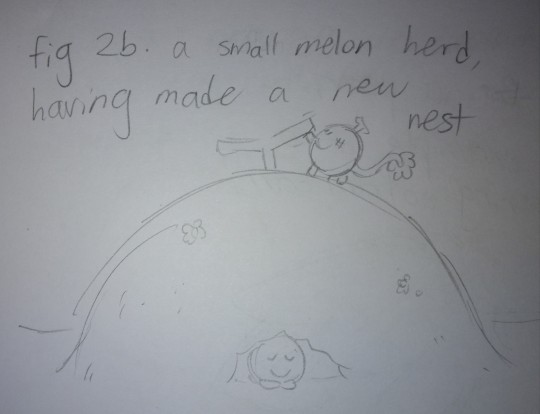
roaming botanicans are quadrupedal (four vine legs) with a prehensile vine-and-leaf tail (fig 2a); they live in sibling herds (usually small, but can vary in size) and roam around the landscape, without any designated leader among them. most roaming botanican species follow the sun year-round, and so avoid winter; in their constant migration they periodically stop to rest at hills, under which they burrow to make a nest. after making a nest under a hill, a herd will stick a branch at its peak so, after they leave, other herds will know that that hill can be used as a nesting site (fig 2b). some roaming botanicans have evolved to have particularly thick rinds, and so are more cold-resistant, and so opt not to constantly migrate, instead living more sedentary lives with occasional migration.
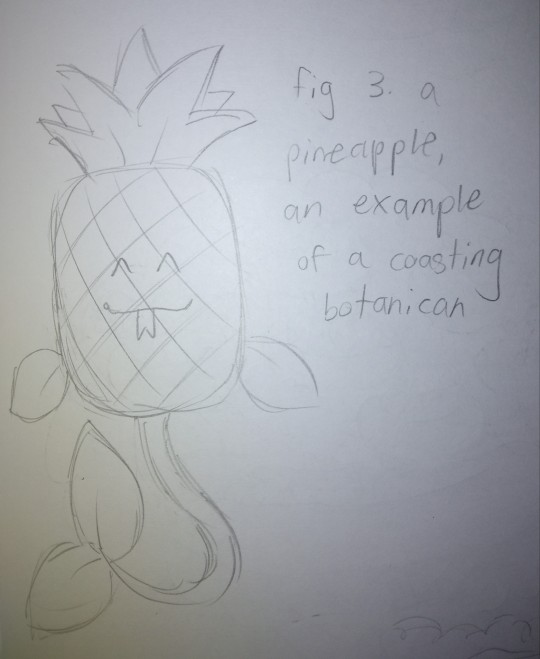
coasting botanicans have a stem-and-leaf tail and two leaf fins (fig 3); they grow on land but live the majority of their lives in the water, where they spend their time in groups. these groups are more based on friendship ties than familial ties, considering how vast a domain these botanicans have (basically the entire aquatic realm). more so than others, coasting botanicans connect with botanicans of other species and categories, and spend most of their lives just exploring and meeting others. while usually surrounded by others, a coasting botanican might on a rare chance find themselves alone in the ocean, in which case the loneliness will cause them to act in a way abnormal for most of their category - they will become antisocial and will lose their desire to explore. there are few cases of this occurring, however, given how populated and lively most corners of botanica's waters are.
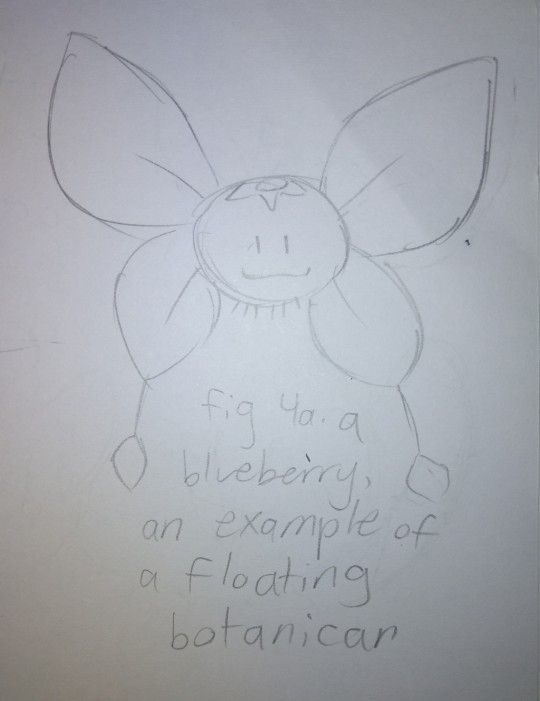
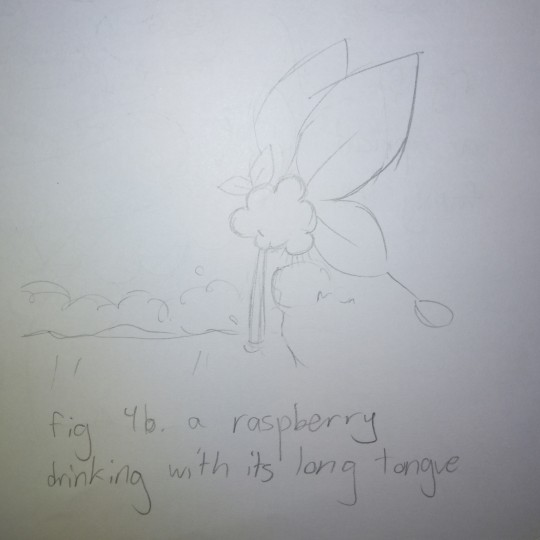
floating botanicans have four large leafy wings and six tiny stem feet (fig 4a); they are the most solitary of the four categories, being very individualized. they have a very strong connection to flowers, which they in fact pollinate - many cultivate their own gardens and end up specializing in a specific type of flower. floating botanicans can be very social at times, and often come together to form collaborative gardens and even breed flowers, but they do not live in groups. these botanicans, being so much smaller than the others, can often not safely drink out of rivers or lakes without falling in, and so have evolved a long root tongue to drink with (fig 4b).
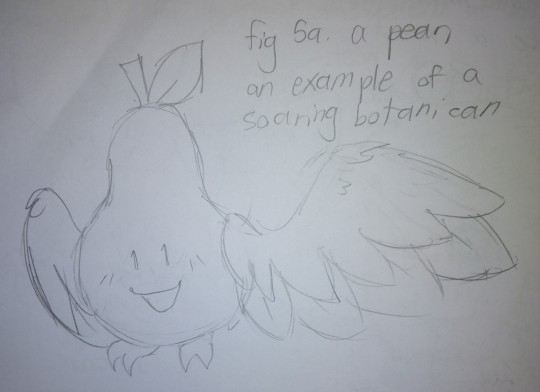

soaring botanicans have two large, leafy wings and two stem talons (fig 5a); they tend to live in very large familial flocks, as fruit trees often produce mass amounts of botanicans. the first to ripen is usually the leader of the flock. these botanicans build nests in their family tree (get it?) using fallen sticks, branches, and other plant materials, which becomes the center of life (fig 5b). within a flock of soaring botanicans, many individuals are designated to explore the surrounding area for interesting additions to the nests (such as a foreign flower or a pretty rock). due to the large size of these groups, most individuals within a flock form a "twin" bond with another individual, which they spend more time with than others.

i don't think i ever came up with a name for the soaring-coasting subcategory, but in any event, these botanicans have a single broad leaf tail and two stem talons (fig 6). these botanicans are more closely related to soaring botanicans than coasting botanicans, but as they tend to live in more watery areas, they have many similarities to coasting botanicans and do not have the capability of flight. botanicans of this category live in large flocks in ponds, lakes, and rivers; many build small dams. unlike those of the typical flock of soaring botanicans, individuals within flocks of these botanicans tend to intermix more; they often make friends between flocks and so there seems to be some kind of broad botanican network from pond to pond, river to river, lake to lake. these botanicans, like coasting botanicans, are very friendly and carefree.
botanica is a peaceful, happy planet; basically every resource needed for survival is in abundance and there is no opportunity for greed and selfishness to even arise, so individuals are more often than not cooperative, kind, and generous. of course, as loss and loneliness are truths of life, no botanican life is free of all suffering altogether, and issues can arise - but given the warm, compassionate nature of the surrounding physical and social environments, individuals end up living happy, loving lives overall.
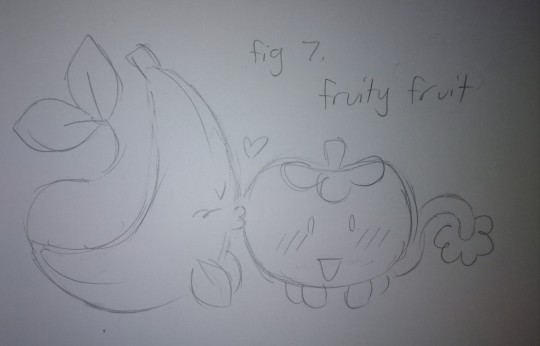
something interesting about botanican life is the complete disconnect between reproduction and relationhips - seeds are only spread after a botanican passes away, and those seeds grow into plants otherwise entirely disconnected from the botanican in question; then those plants are pollinated and new botanicans grow from them. in this way, botanicans have no real concept of sex, and often fall in love with and befriend members of different species (as there is no reason why this would be an issue; they wouldn't be reproducing with them anyway) (fig 7). while plant individuals sometimes have parts of a specific sex, most have parts of both sexes, and either way this has no impact on the mindset or behavior of the botanican as a whole creature (they technically have biological sex but they have no gender).
...so yeah, here's my silly fruit world!!! there's a lot of stuff left to talk about (with the gods of the world and everything) but this is good to start with :) i hope you like it!!!!
#dandy's doodles#botanica#osc#<- i never know if this really counts but i guess it does#this whole thing was very first created like 5 years before i even learned about the existence of object shows#but y'know there's a connection here#the reason why i love object shows so much is because i already personified inanimate objects!!#so yeah i guess this counts :)
46 notes
·
View notes